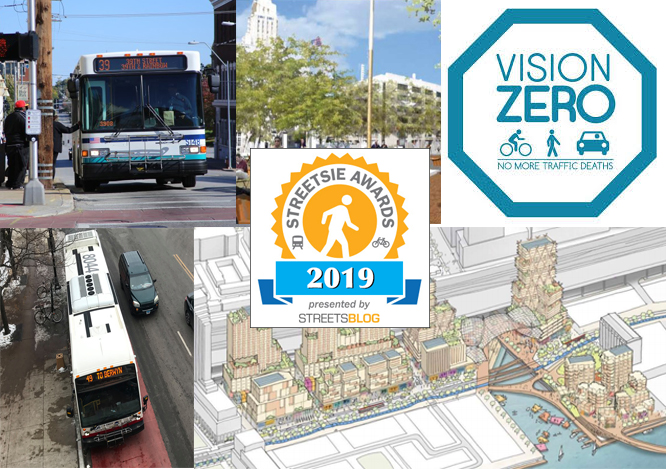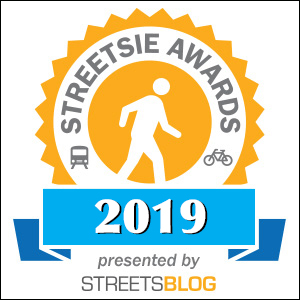The Transportation Research Board’s 99th Annual Meeting will be held in Washington, D.C. from Jan. 12-16, 2020. Click here for more information.
As we close 2019, it is time to recognize the street designs that made our communities more livable and safer.
Like the Oscar for Best Picture, there's something for everybody: Blockbuster proposals like free transit! Smart city developments! Traffic calming medians! New bus shelters with Adam Sandler's face on them!
One caveat: This year's nominees would certainly have included New York City's passage of a "streets master plan" bill that requires the mayor to build 250 miles of protected bus lanes and 150 miles of dedicated bus lanes over the next five years, but the bill passed partly because 29 cyclists have died on Gotham streets this year, so the city hardly gets credit for finally recognizing it has a problem. Vision Zero isn't just about the first word — it's about the second one.
So for now, here are the nominees for the Janette Sadik-Khan Award for Boldest Plan:
San Francisco's Car-Free Market Street
People have been calling for a car-free Market Street since "Mrs. Doubtfire" was a hit in theaters. But advocates flooded an SFMTA board meeting in October to see the moment when board members finally approved the proposal barring vehicles from a two-mile stretch between Octavia and Embarcadero.
The new plan won't just restrict sedans, SUVs, Ubers, and cybertrucks from using San Francisco's busiest street. The city will be spending $500 million to build sidewalk-level bike lanes, add new bus-boarding islands, shaping curbside lanes for taxis and commercial vehicles, replace trolley wires, and maintain sewers and utilities, as our Streetsblog SF colleagues catalogued.
Construction for those projects may not begin until 2025, but pedestrians will begin to see the effects of less car traffic in the heart of downtown as soon as Jan. 1, when the vehicle ban goes into effect. Seems like a great day for a stroll to the Wharf!
During peak hours, there are 100 buses running in either direction on San Francisco's Market Street. By next year, the city plans to kick cars off the street. https://t.co/FFJcT9QI0t
— POLITICO (@politico) May 27, 2019
Chicago's Bus Priority Zones
Chicago has a measly amount of dedicated bus lanes. At the beginning of the year, the Second City counted only four miles of busways compared with New York's 82.8 and Los Angeles's 35.4 miles. But that's beginning to change as the city attempts to improve service along several lines through the Bus Priority Zones program.
The plan includes longer boarding areas, repaving, and new signage at the Chicago, Milwaukee, and Ogden Avenue intersection — a key interchange that serves one of the city's busiest routes, new bus lanes and transit signal priorities on Western Avenue, and several improvements on four sections of 79th Street, according to Streetsblog Chicago.
This year new mayor Lori Lightfoot announced that the budget for the program was being expanded from the original $5 million to $20 million, with some of the funding coming from a new ride-hail tax. The program includes red bus lanes, overhead signs, signals that give buses a head start over vehicles at intersections, and extending sidewalks for pedestrians.
Chicago's Bus Priority Zone program shifts into higher gear - Streetsblog Chicago: https://t.co/UrOOkv7PgP #CTA #Metra #Transit #Chicago #Transportation
— MyTransit Chicago (@MyTransit_CH) December 5, 2019
Alphabet's Sidewalk Labs in Toronto
What if a tech company controlled nearly every aspect of planning for a new neighborhood from the ground up? We're finding out the results in Toronto where Google's Sidewalk Labs unveiled a 1,542-page plan to convert the city's industrial Quayside neighborhood into a high-tech community.
The vision consists of using machine learning and a design tool to generate planning scenarios and consider data sets containing zoning regulations, income variations of families, density, and walkability when designing communities. Planners will use this data an analysis to make decisions about what to build although the basic principles include 10 new buildings with housing and retail, extending light rail service to the area, redesigning streets to encourage cycling and walking, and installing WiFi as well as sensors to collect data about traffic, waste management, and other services.
It's one of the most innovative plans of the year, if not the decade, but Toronto residents have deep concerns about personal privacy and how Google will collect data in the community. After significant media scrutiny, the company has since scaled back its plans.
SCOOP: Waterfront Toronto + Sidewalk Labs's smart-city negotiations have moved toward the original 12-acre plan with revamped privacy asks, greater protections for Canadians to profit from innovations. Many concessions to June master plan. Vote is Thursday https://t.co/y8ymsMhdw1
— josh o'kane (@joshokane) October 29, 2019
Kansas City Free Buses
The home of jazz and barbecue that straddles the Midwest and the Great Plains is not often considered at the forefront of transportation innovation. That changed this year when the Kansas City City Council passed a measure covering bus ridership for its residents.
The move which made Kansas City the largest metropolis in the nation to provide free transit generated national news coverage and inspired discussions about whether transit is a right and the challenges that come with providing free transit to the masses. Will ridership go up or decline if the service is free? Will service get better or worse? Will the Missouri legislature and the federal government step up and fund the much-needed expansion of the region's bus and rail system? We'll find out soon enough.
Ring in #2020 safely. #RideKC transit is free after 4 PM on New Years Eve! #NewYearsEve #NYEKC pic.twitter.com/imyWllekXQ
— RideKC (@RideKCTransit) December 30, 2019
Montgomery County's Vision Zero Strategies
Vision Zero strategies have gotten widespread support in cities where there are dense communities of people who live without a car and demand safer streets. But in suburban areas that have ceded their streets to vehicles for decades the challenges of reclaiming roads for its pedestrians are significantly greater. Fortunately there's some hope based on the efforts of Maryland's Montgomery County, a transit-rich area north of Washington D.C.
Transportation officials there are in the process of implementing its bicycle master plan and developing a pedestrian one, lowered the speed limit of multi-lane roads, encouraged development near rail stations, and worked to change the culture in county government to plan communities for all users of the road. As millennials continue to migrate from cities to nearby suburbs in search of cheap housing, getting a head start on the aspects of urban life that attracted young people to cities in the first place could give suburbs like Montgomery County an advantage over other regions.
LA Busways, Metro improvements, and Bus Shelters
Los Angeles International Airport needed to end the nightmarish traffic jams leading into and out of its terminals so it did what any reasonable authority should do — it banned curbside pickups from taxis and added a new busway. The move which allowed shuttle buses to whisk Uber and Lyft customers to a designated pickup area a few minutes away from the terminal entrance while giving preference to buses to zoom through the terminal.
There are long-term plans to extend Metro Rail service to LAX and make approaches more pedestrian friendly with an automated people mover too, as our Streetsblog LA colleagues note, but a bus-forward approach is a good first step. As for the greater Los Angeles area, ridership hasn't bounced back on the refurbished A and E lines, but there is optimism as the Gold Line continues to be extended, and plans for Metro stop at UCLA continue to be discussed.
Meanwhile Mayor Eric Garcetti is moving to add more shade to 750 bus stops with additional tree plantings, umbrellas and sails to make waiting for the bus more comfortable. If bus-only lanes become permanent and widely deployed, ridership could improve there too.
Winner: Kansas City's Free Transit. When you have advocates from coast to coast, and a few presidential candidates, talking about whether transit should be a right, you deserve a Streetsie. Now please send us your finest barbecue.







